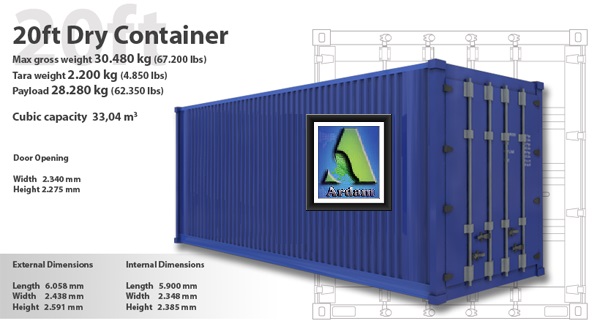Container dimensions
Ardam Global Express Company Container information

An inter-modal container is a large standardized shipping container, designed and built for intermodal freight transport, meaning these containers can be used across different modes of transport – from ship to rail to truck – without unloading and reloading their cargo. Inter-modal containers are primarily used to store and transport materials and products efficiently and securely in the global freight transport system, but smaller numbers are in regional use as well. These containers are known under a number of names, such as simply container, cargo or freight container, ISO container, shipping, sea or ocean container, container van or (Conex) box.
Inter-modal containers exist in many types and a number of standardized sizes, but ninety percent of the global container fleet are so-called “dry freight” or “general purpose” containers, durable closed steel boxes, mostly of either twenty or forty foot (6 or 12 m) standard length.The common heights are 8 feet 6 inches (2.6 m) and 9 feet 6 inches (2.9 m) – the latter are known as High Cube or Hi-Cube containers.
Just like cardboard boxes and pallets, these containers are a means to bundle cargo and goods into larger, unitized loads, that can be easily handled, moved, and stacked, and that will pack tightly in a ship or yard. Inter-modal containers share a number of key construction features to hold-up to the stresses of inter-modal shipping, to facilitate their handling and to allow stacking, as well as being identifiable through their individual, unique ISO 6346 reporting mark.
In 2012 there were about 20.5 million inter-modal containers in the world of varying types to suit different cargoes.[3][nb 2] Containers have largely supplanted the traditional break bulk cargo – in 2010 containers accounted for 60% of the world’s seaborne trade.[6][7] The predominant alternative methods of transport carry bulk cargo – either gaseous, liquid or solid – e.g. by bulk carrier or tank ship, tank carer truck. For air freight, the more light-weight IATA-defined unit load device is used.
https://en.wikipedia.org/wiki/Intermodal_container
Comments are closed.